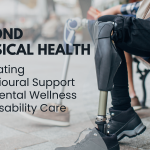As we watch the people we love grow older, it’s hard not to feel that slow pull of time. Sometimes it’s quiet and gentle—missing keys again, forgetting a pot on the stove, leaving mail unopened. Other times it’s louder: a bad fall, a confusing night, or a call from a neighbor who’s starting to worry. Figuring out when to step in and make a change is never easy. But knowing when someone might be ready—or even need—to move into an assisted living facility can help keep them safe, supported, and still feeling independent in the ways that matter most.
No one wants to think about the people they love losing their freedom. But the truth is, assisted living doesn’t mean giving up on life. In many cases, it’s where a new chapter begins—one with less stress, better care, and sometimes even more social connection than before. Still, the signs can be blurry, and the decision can feel heavy. That’s why we’re breaking it down with real talk, so you’ll know what to watch for and how to handle it if the time comes.
Daily Life Is Getting a Lot Harder
If everyday routines are becoming more like uphill climbs than smooth habits, it might be time to take a closer look. Maybe Mom used to love baking and now she barely steps foot in the kitchen. Or maybe Dad always paid his bills on time but suddenly there are unopened envelopes stacking up. These little shifts in how they manage personal care, meals, medication, or money can say a lot.
Sometimes it’s physical—aches, fatigue, or slowed reaction times. Other times, it’s mental—confusion, forgetfulness, or growing anxiety about things that never used to bother them. You might also notice they’ve stopped going out as much. Isolation is sneaky. They might say they’re just “taking it easy,” but it could be a sign they’re struggling more than they let on. The goal isn’t to hover, but to stay aware. Independence matters, but safety does, too.
Money Worries and What Comes Next
Let’s talk about the elephant in the room—what it costs. A lot of families avoid the assisted living conversation for one big reason: money. It can feel overwhelming, especially if your loved one is living on a fixed income. But there are options for paying for a nursing home out there that can actually take some of the pressure off.
Depending on your family’s situation, there may be programs, insurance plans, or even financial planning tools designed specifically to support older adults transitioning into long-term care. The key is not to assume it’s all out of reach. Yes, it takes research and sometimes paperwork, but financial help exists—you just have to know where to look and not be afraid to ask. Planning ahead, even just a little, can make the whole process less stressful when the time actually comes.
Safety Isn’t a Given Anymore
This is often the tipping point. When you can’t sleep at night because you’re wondering if your dad fell in the bathroom—or worse, if no one would know if he did—that’s when the conversation starts to shift. Sudden weight loss, burns from the stove, bruises, or unexplained dents in the car are real signs something is off.
You may start noticing your loved one is calling you more—asking how to reset the thermostat or manage a microwave. Or maybe they’ve gotten lost on their usual route to the pharmacy. These things matter. They’re not just small mistakes. They’re signals that managing life at home may no longer be safe. When that becomes the new normal, choosing the right assisted living facility becomes not just a next step, but a necessary one.
You’re Doing More Than You Can Handle
If you’re the main support person, you probably feel the weight of it more than anyone else. At first, it may have been manageable—checking in now and then, running a few errands, handling appointments. But as needs grow, your own life might start to shrink. That’s not selfish; it’s reality.
Caregiver burnout is real, and it doesn’t make you a bad person. It means you care. And sometimes, the kindest thing you can do is recognize when your loved one needs more care than you can give. Assisted living isn’t a sign that you’ve failed. It’s a sign that you’ve done all you can—and now you want them to have the right team, the right setup, and the right kind of support. That’s not giving up. That’s stepping up.
They’re Lonely, Even If They Don’t Say It
You can be surrounded by people and still feel completely alone. Many older adults hide how isolated they feel, especially if they’ve lost a spouse or close friends. You might notice your loved one doesn’t answer the phone as much anymore, or they’ve stopped going to church or bingo or whatever used to bring them joy. Depression in older adults can look like a lot of things—tiredness, loss of appetite, irritability—but the common thread is withdrawal.
One of the most unexpected gifts of assisted living is the social life. Community dining, group activities, planned outings—things that once felt impossible can suddenly be part of daily life again. Being around others in a similar stage of life often brings comfort. It’s not about putting them in a facility. It’s about giving them a chance to feel part of something again.
The Bottom Line
You don’t have to wait for a crisis to make a move. The best time to talk about assisted living is before it’s urgent. That way, your loved one can be part of the conversation, visit a few places, and ease into the idea without panic or pressure. It won’t be easy. But it can be loving, honest, and even hopeful. Keep your eyes open, your heart soft, and your expectations realistic. When the time comes, you’ll know—and when you do, you’ll be ready to help make the next step one filled with care, comfort, and peace.
Lynn Martelli is an editor at Readability. She received her MFA in Creative Writing from Antioch University and has worked as an editor for over 10 years. Lynn has edited a wide variety of books, including fiction, non-fiction, memoirs, and more. In her free time, Lynn enjoys reading, writing, and spending time with her family and friends.















